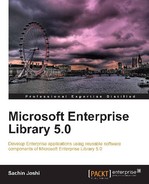This book covers the fundamental elements of each application block so that you get a good understanding of its concepts. This is followed by referencing the required and optional assemblies and then initial configuration of that block using the configuration editor. Finally, it leverages the application block features to achieve goals of enterprise application development.
Chapter 1, Getting Started with Enterprise Library, introduces us to the Enterprise Library and explores various application blocks such as Unity, Policy Injection, Data Access block, Logging block, Exception Handling block, Caching block, Validation block, Security block, and Cryptography block.
Chapter 2, Data Access Application Block, explores the fundamental elements of the Data Access Application Block such as Database, SqlDatabase, OracleDatabase, SqlCeDatabase, GenericDatabase, Parameter Mapper, and Output Mappers.
Chapter 3, Logging Application Block, explores the fundamental elements of the Logging Application Block such as Log Category, Special Category, Logging Trace Listeners, Log Formatters, Logging Filters, Logger, LogWriter, LogEntry, and so on. We also learn about the various required and optional assemblies and learn to set up the initial configuration.
Chapter 4, Exception Handling Application Block, introduces us to the fundamental elements of the Exception Handling Application Block such as Exception Policy, Exception Types, and Exception Handler. We also learn about the required and optional assemblies, the initial infrastructure configuration, and the individual feature-level configuration.
Chapter 5, Caching Application Block, teaches us the fundamental elements of the Caching Application Block. We further learn to configure an encryption provider to encrypt cached data while using a persistent backing store.
Chapter 6, Validation Application Block, teaches us to validate objects using various approaches such as using an attribute, self-validation, programmatically, and through configuration. We also learn how the Validation Application Block can be integrated with Windows Forms-based applications and ASP.NET web applications.
Chapter 7, Security Application Block, introduces us to the key features of the Security Application Block and explores the elements of Authorization and Security Cache Providers. We also learn about the various required and optional assemblies.
Chapter 8, Cryptography Application Block, introduces us to the fundamental elements of the Cryptography Application Block such as IHashProvider, ISymmetricCryptoProvider, CryptographyManager, and so on. We also learn to generate hash, compare hash, and implement a custom hash provider. We also explore encryption and decryption of data and understand the basics of implementing a custom symmetric cryptography provider.
